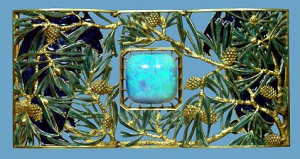Renè Lalique (1860-1945) was a French glass designer with extremely sophisticated touch, master of Art Nouveau and Art Deco. He was designing perfume bottles, vases, clocks, mirrors and especially jewellery. Some of his pieces are a part of the permanent collection in Gulbenkian Museum in Lisbon. In his artistic attempts, Lalique was way ahead of his time, which the following jewellery pieces can confirm. The endless inspiration for Lalique was the nature and his pieces carry the unique combination of quality materials, lovely colours, and different motives.
‘Dragonfly’ Brooch
One of the most extravagant and beautiful pieces is ‘dragonfly-woman’ brooch which was presented at the Paris Universal Exhibition in 1900. At the same time, this broach causes admiration and disgust, but most of the people are strangely drawn to it. The figure of the woman emerges from the mouth of the large gold and enamel dragonfly with its griffin’s claws and open wings, with extremely detailed enamel decoration, diamonds, and moonstones.
Plaque for Choker ´Eagles and Pine´ 
This lovely detailed plaque for a choker feature square cabochon opal in the centre of the gold and green cast and chased gold which forms pine branches with two facing eagles. With this much details, one may think that this is a very tasteless piece of jewellery. However, Lalique was the expert in the presentation of confronting motives.
´Chrysanthemum´ Pendant and Brooch
It is one of the best examples of Lalique´s hard and detailed work, where he represented three lovely light-blue flowers, adorned with diamonds and pearl. Lalique loved the idea that his items can be used in several different ways, therefore this brooch and pendant.
Female Face Pendant
Inspired by Renaissance Lalique creates the pendant with a female face made of opalescent glass. The face is surrounded with patinated silver poppies on her head and hair which almost resembles roots from which hangs a large baroque pearl. Like the most of the Lalique´s pieces the pendant has no symmetry and the combination of several motives and materials makes a great statement.
‘Rape of Deianira’ Pendant
This beautiful pendant was inspired by the Greek mythology and the scene in which Centaur Nessus rapes Deianira. The figures are made of ivory and their execution is very detailed. The two are surrounded with greenish seaweed made of enameled gold and triangular opal stone hanging from the lower part of the pendant.